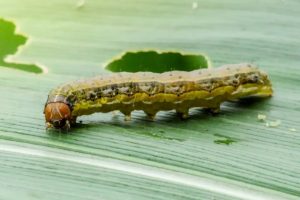
The Life Cycle of Armyworms
Armyworms go through a fascinating life cycle that spans multiple generations. The adult moths, which are brown in color, lay their eggs in clusters of 100 to 200 underneath leaves. Once hatched, the tiny caterpillars begin their feeding frenzy, growing to a size of around an inch and a half within two to four weeks. They then burrow into the ground, spin a cocoon, and emerge as moths to repeat the cycle.
Identifying Armyworms
To effectively combat armyworm infestations, it is crucial to be able to identify them accurately. Armyworms are not actual worms but rather caterpillars with distinct characteristics. They can range in color from green to brown to black, with a wide black stripe running down each side of their bodies. Additionally, they have an upside-down Y marking on their heads. If you notice an unusual number of birds on your lawn, it may indicate an armyworm feast.
The Armyworm Invasion
This year, the mid-Atlantic region has experienced an unprecedented armyworm invasion, leading to widespread devastation of lawns, golf courses, and crop fields. Experts believe that the increase in tropical weather systems and hurricane activity has facilitated the early arrival of moths in the area, resulting in a higher number of generations of armyworms and subsequently more damage.
The Impact on Landscaping
While warm-season grasses can typically regenerate after an armyworm invasion, cool-season grasses found in the mid-Atlantic region may suffer permanent damage. Armyworms devour the plant tissue, leaving lawns looking brown and barren. However, there is hope, as green growth can often be found at the crown of the grass, indicating the potential for recovery.
Effective Control Measures
Controlling armyworms requires swift action and a multi-faceted approach. Several insecticides are available for combatting armyworm infestations. Bifenthrin, although effective, provides only short-term protection. Acelepryn, on the other hand, offers longer-lasting control of up to five weeks. It is important to note that these products should only be used when armyworms are present, as they are not preventive treatments.
Scouting for Armyworms
To effectively control armyworms, it is crucial to scout for their presence. By inspecting the lawn and pulling back sections of turf, you can identify the caterpillars. This scouting process is similar to searching for grubs. If armyworms are detected, prompt action can be taken to control their population and minimize damage.
Expert Advice and Solutions
For landscaping professionals and homeowners dealing with armyworms, seeking expert advice and solutions is essential. Companies like Green & Grow offer recommendations for effective products such as bifenthrin and acelepryn. While supply chain issues may impact availability, alternative solutions can be explored. It is crucial to consult professionals and implement control measures as soon as armyworms are identified.
Prevention and Future Considerations
While it may be challenging to entirely prevent armyworm infestations, there are measures that can be taken to minimize the risk. Establishing proper lawn care practices, such as regular irrigation and appropriate nitrogen fertility, can promote healthier grass and potentially deter armyworms. Additionally, staying informed about weather patterns and the potential migration of armyworm moths can help anticipate future invasions.
Armyworm Control Services
Armyworms will eat every part of the grass blade, all the way to the beginning of the root. They will leave just particles of chewed leaves where you lawn used to be. A collection of armyworms can destroy an entire lawn within a few days. As armyworms feed, they leave brown patches in the lawn that can appear to look like heat, drought, or chemical stress.
> Learn More
Armyworms can wreak havoc on lawns and landscapes, causing extensive damage in a short period. By understanding their life cycle, identifying their characteristics, and implementing effective control measures, it is possible to combat these voracious pests. Swift action, expert advice, and a proactive approach to lawn care can help maintain healthy and vibrant landscapes even in the face of an armyworm invasion. Stay vigilant, scout for their presence, and take the necessary steps to protect your green spaces.
Contact us (859-314-LAWN) for more information or a free instant quote!
—
 About Green & Grow
About Green & Grow
Green & Grow is a full service lawn care company specializing in lawn mowing, fertilization & weed control, aeration & seeding, insect control, and more!
> Learn More

 About Green & Grow
About Green & Grow